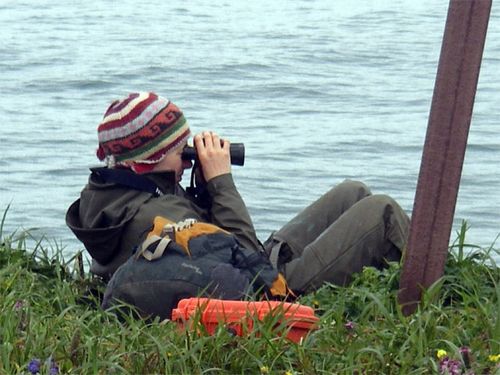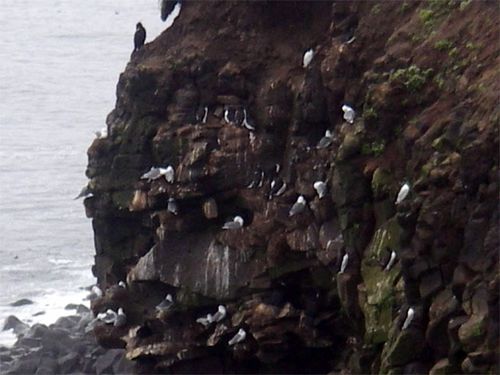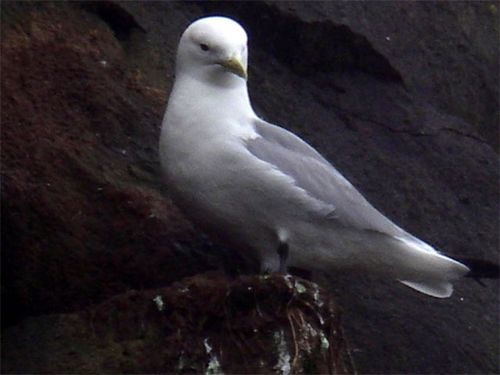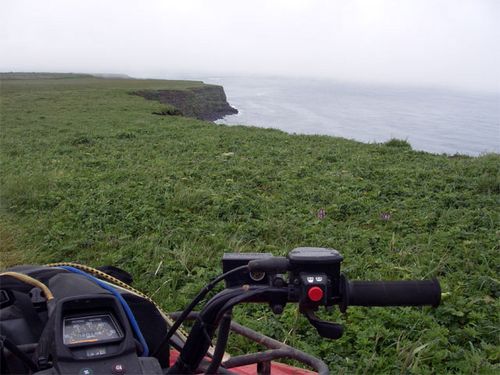I pulled the early shift for the seabird project today. Early, as in arrive at the study site, a 50 minute drive by ATV, BEFORE sunrise. Not a problem, I like the early morning hours, especially when making a contribution to a study as important and exciting as this one.

In addition to the high tech gadgetry that is being deployed, part of our work involves making straightforward observations of the birds. It has been a very tough year for Black-legged Kittiwakes. Many of the birds that have tried to nest this year have failed. This means that birds have either not attempted to nest, nests have been abandoned or their chicks have died. This is probably connected to the lack of the availability of food in the surrounding area. If there is not much food, it is difficult to keep a hungry chick alive for the 36 days or so that it takes for it to develop from a tiny little chick that hatches from the egg, to a fledging that is able to fly and catch food on its own.

The scientists knew from their observations, the location of a small group of kittiwakes that were attending chicks at the nest. In kittiwakes, both parents typically provide care for the young. One parent normally remains at the nest with the chick while the other flies off in search of food to feed the youngster. As mentioned in the post the other day, this may involve trips of up to 70 miles, or even longer. Sometimes the trips are short ones, it just depends on where the fish are! Typically the mates will switch, meaning that when one bird flies in with a meal for the chick, the other parent flies off and goes looking for more food. The newly arrived bird becomes the attending parent and watches over the chick and protects it from the elements and from other birds.

The scientists want to learn about the amount of time that the birds are at sea searching for food. This practices involves the careful watching of the nests throughout the day and into the night (remember how light it stays at this time of year). Just like for the kittiwakes attending the chicks, for the research team, this means shift work. One team member arrives at sunrise and then we rotate through our watches in 4-6 hour shifts.
On my first shift on the cliff, I was introduced to the method for observing the birds. There were seven nests that were known to have chicks. My first step was to recognize the nests and to learn their assigned number so that we could keep track of the activity in each nest. This is harder than it sounds because some birds were sitting on eggs (we weren't counting those), other birds were simply roosting, or hanging out on the cliffs (we weren't counting those either). All of the while, other birds are constantly flying onto and off of the cliff face. But after a few minutes of careful watching, you begin to pick up on the nests and the birds to keep an eye on.

On the first shift, at sunrise, all of the birds attending the nests are designated as bird "A" for that particular nest. Once a switch occurs and the mate flies in, the time is recorded, we look to see if a chick was fed (that's always the hope) and then the new bird is designated as bird "B". When bird "A" returns to the nest, usually after a couple of hours or more, the time is recorded again, providing a record for the amount of time that the parent spent out hunting for food. The watches are often slow, sometimes an entire hour might go by without a returning bird. But for me, the time really flew on by. Sitting on a cliff, high above the Bering Sea with every manner of seabird passing by, it doesn't get much better than that!
Bird Species seen: Red-faced Cormorant, Harlequin Duck, Northern Pintail, Parakeet Auklet, Crested Auklet, Least Auklet, Tufted Puffin, Horned Puffin, Thick-billed Murre, Common Murre, Northern Fulmar, Red Phalarope, Wandering Tattler, Gray-tailed Tattler, Rock Sandpiper, Semi-palmated Plover, Ruddy Turnstone, Black-legged Kittiwake, Red-legged Kittiwake, Glaucous-winged Gull, Snow Bunting, Lapland Longspur, Gray-crowned Rosy Finch.
Mammals: Northern Fur Seal, Harbor Seal, Arctic Fox


Comments